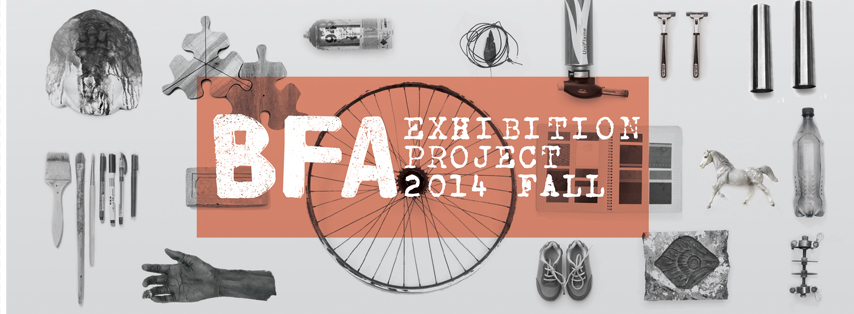BFA Exhibition Project 2014
 Venue: Nepal Art Council Gallery, Babarmahal, Kathmandu
Venue: Nepal Art Council Gallery, Babarmahal, Kathmandu
1-6 August, 2014
The BFA Exhibition Project is the culmination of four years of creative experiences galvanized in the integrated projects of students graduating with degrees in Graphic Communication and Studio Art from Kathmandu University, School of Arts, Center for Art and Design (KU Art+Design). The exhibits at the BFA Exhibition Project 2014 are the outcomes of six months of intensive studio-work by our seventeen graduating students. These self-motivated projects were mentored by our faculty members and invited experts, who encouraged the students to explore possibilities to realize their concepts and visions. They were encouraged to trust their creative processes and investigate conventional and unconventional mediums. The students accepted these challenges and pushed the boundaries of their practice. These works are the result of their processes, the issues they are concerned with, the ideas they believe in and are passionate about, and viewpoints they wish to share with us.
On the one hand, Kiran Rai fantasizes about motion in immobile mythical creatures found at traditional temples of the Kathmandu Valley. He invites the new generation to enthusiastically entertain a fresh perspective towards overlooked traditional imageries and their mythological origins. On other hand, through his graphic designs and illustrations, Mathias Plank takes his viewers into an alternative reality – Alter, an imagined world where strange creatures and mystical beings dwell.
Prabal Bikram Shah’s artistic interpretation of newspaper pages provokes a new understanding of our socio-political issues. Although these issues dissipate and subside over the course of time, they are still pertinent and their consequences inescapable. Therefore, Shah seeks to reestablish these issues for further discourse.
Death is a surreal possibility for Kiran Maharjan, who believes it is a process of decaying, thus a process of transformation into a new form. It is a threshold between being a human and process of rejoicing into a renewed reality in death. He has explored the topic of surreal possibilities of life by understanding death, and the process of decay and transformation. He has depicted the value of life and death in different phases and its natural phenomenon.
Bikash Tamakhu is concerned about the overlooked cultural heritages around his hometown of Bhaktapur because of the haphazard urbanization. His struts represent the cultural and aesthetic values of old architecture, but, due to modernization, they haven’t been paid heed to. Tsewang Lama’s concern is also the chaos of urbanization, and is worried about the increasing disharmony between humans and nature. Similarly, Saroj Lamichane perceives brick factories that are overtaking and baking fertile land in their giant smoke-belching kilns.
Prakash Ranjit, in his painting, videos and performance, dares to go beyond the stereotypes of gender, and believes that both the masculine and feminine qualities are present in every human being.
Niroj Maharjan is occupied with the passed down belief that the deity Bhairav has a supernatural power to fulfill one’s wishes. Thus he places his prayers on the traditional masks of Bhairav as to wish upon. Kshitiz Gywali similarly reflects upon the nine classical essences through anamorphic portraits.
Prajwal Bhattarai presents junk materials with a light and sound installation, and an execution of a mechanical composition with melody that will change our perception of beauty. Ramesh Kadayat, in his artwork, reflects the voice of the Kamaiya bonded laborers of his home district through numerous sacred horse sculptures, while Pramod Thapa’s work goes back to his childhood memories with its surroundings, a nostalgic memory that is buried under pollution in the present. His work tells the story of a boy and fish to depict his feelings and responsibilities towards his homeland.
The Graphic Communication group has explored ideas in product designs, rebranding, and a pictorial book. Anish Bajracharya is motivated by homegrown product that has remained stagnant in its form and function without losing popularity. He feels uneasy about the status quo of Nepali products, therefore he has rebranded the product for the urban youth.
Shreejan Shrestha is fascinated with the playfulness of lights. He believes in good design process to create quality products to prepare them for any international market. Ubahang Limbu visualizes his own story in very emotive and cinematic illustrations. The dynamism of his composition and the meticulous craftsmanship he has put into his work will reenergize the illustration sector in Nepal. Lastly, Bhawana Tulachan brings a perfect example of a good blend of traditional motifs with contemporary design. Her design focuses on preserving the beautiful legacy of Nepal’s traditional art and crafts by contemporizing it.
The entirety of this exhibition is a result of the ideas and concepts of the students, honed through constant mentoring. These works portray the individual personalities of the students, their concerns and their visions. These artists make up the new batch of creative individuals who are committed to contributing to the visual culture of Nepal. Kathmandu University, School of Arts, Center for Art and Design, as always, is very proud to present these graduating young talents to you.


